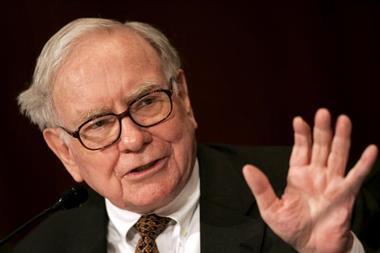Allianz plans to double investment in non-traditional assets as more insurers see the benefits of looking beyond the stock market
This year, a Middle Eastern sovereign wealth fund, one of the world’s foremost investment banks and Europe’s biggest insurer will make $58m (£38.54m) out of the privatisation of 36,000 parking meters in Chicago.
For the insurer, Allianz, the deal, which was signed last year, is an example of just how far it is willing to diversify its investments away from traditional government bonds and equities.
In January, Allianz stunned the market when group board member in charge of finance, Paul Achleitner, suggested that he might double investments in ‘alternative assets’ to around €30bn (£27.25bn). He expects infrastructure investments, which include electricity grids and wind power as well as parking meters, to provide returns of 7%-10%, against an average of 4.5% across Allianz’s assets.
Alternative investments, be they in infrastructure, private equity or commercial property, are expected to counter any dramatic declines in the stock market and low interest rates.
And Allianz is not alone. Several major insurers and groups with syndicates in the Lloyd’s market are ready to diversify and take on that bit of extra risk to improve their financial performances.
Branching out
A quick glance at Allianz’s results for 2008 – the heart of the financial meltdown – shows the problems insurers faced investing in one of their traditional asset classes, the stock market. Equity investments fell €70bn as market values tumbled and so Allianz looked to safer havens.
A spokesman does point out that even if alternative investment does double and real estate development of €16bn-€18bn is included, it would still only constitute a relatively small portion of the €409bn of customer funds in insurance policies that it manages.
But for the typically conservative composite to diversify further is a sure signal that traditional investments aren’t producing.
The key is to make sure these alternatives aren’t going to fail.
For example, private equity looks like a particularly risky investment. Prior to the summer 2007 financial collapse, these buy-out firms were borrowing up to 90% of the money they needed to purchase portfolio companies. As these companies underperformed in the recession, so private equity could not meet their loan conditions and had to relinquish control of the businesses to the banks.
Allianz invests E8bn in private equity. Usually a buy-out firm raises a fund from many investors, but Allianz is the sole backer of its private equity managers. “We are a captive investor,” the spokesman says. “Managers need to apply to Allianz for money and to get approval for the different projects they want to buy.”
Therefore, Allianz exercises greater control over its private equity investments than the typical funder, eliminating some of the risk but allowing it to get close to the 20% returns expected by the major buy-out firms.
Fixed-income assets, or bonds, are the backbone of insurance investments. Government bonds, which are used to pay off national debt or major public works, are virtually guaranteed, while major corporates with strong credit ratings are also hugely secure. But much of the return is dependent on interest rates, which have fallen in most major economies as governments look to stimulate the housing markets and encourage spending.
For 12 consecutive months, the UK cost of borrowing has been held at a negligible 0.5%. AXA UK finance director Jean Drouffe explains: “The drop in interest rates hits [returns] quite massively. The two main drivers of profitability are insurance trading and investments. It has not been abnormal to see investment income fall by half.”
Of the £300m-£400m of funds AXA invests in the UK through general insurance, about 10% is currently spent on alternative classes. Drouffe includes property; mezzanine debt, which provides high returns as it is less secure than other loans; and collateralised debt obligations, which are packages of small parts of bigger loans – fiendishly complicated but hugely rewarding.
Drouffe says that AXA UK started to invest in this “pocket” of alternative assets about five years ago, but later reduced them as a percentage of the overall portfolio to 6%-7%. This was brought back up to 10% last year as traditional classes felt the squeeze.
Safe bets
Yet some institutions remain almost completely risk averse. RSA prides itself on a low-risk strategy, which helps explain a 9% fall in its investment income to £595m in 2009 on the previous year. Specifically, bonds fell £12m to £466m.
A spokesman for Lloyd’s points out that about 95% of its investments are in government bonds and in cash. “We remain ‘boring but beautiful’,” laughs the spokesman.
At first glance, this strategy appears to be working. Its last results, for the six months to 30 June 2009, show that investment return more than doubled on the same period in the previous year, to £708m.
But the Lloyd’s chairman and chief executive’s statement in the interim report admits that “returns remain relatively modest”, surely a result of relying on assets that are dependent on interest rates.
Perhaps by virtue of their histories and ties to trust funds regulated by ultra-conservative regulators in New York, groups with syndicates in Lloyd’s seem to be a little more conservative than the big composites. Also, their experiences have run counter to those larger peers who are now turning more heavily to alternative assets.
Hiscox group investment officer David Astor says: “The theory behind alternative assets is jolly good, as they provide steady returns. [But] within Lloyd’s, some in the last five to 10 years got more aggressive in allocating to hedge funds and equities, and they came unstuck in 2008. Without exception, they’re now reversing.”
A high-profile example is Chaucer. The group lost £26.2m in 2008, primarily down to investing heavily in hedge funds, and as a result of its weakness became an acquisition target. In 2009, it changed its investment strategy and sold out of hedge funds and equities, making a £42m pre-tax profit.
Away from the Lloyd’s market, at board level Astor admits that Hiscox is a little more risk-taking and invests in hedge funds that have fairly straightforward strategies.
“As long as I understand what they’re doing, we’re happy to back them,” he says.
And the company’s full-year results, announced earlier this month, seem to back up the strength of this simple approach: investment returns of 7.2% helped deliver the company’s record £320.6m pre-tax profit.
Same risk, different name
Amlin chief investment officer Jayne Styles thinks that many insurers have failed to understand what truly constitutes an alternative asset. For example, she says that private equity returns are “highly correlated” with what happens in the equities market.
Unlike some of her peers, she believes that private equity is essentially a like-for-like swap for equities and therefore just represents another asset within the same risk class. “True diversification is between risk and safe haven assets,” she argues.
Styles says that many genuine alternative assets are long-term commitments, much like Allianz’s infrastructure assets, so provide constant returns but are difficult to sell on quickly.
“As a long-term investor, we are more comfortable with property investment,” she says. “It offers some inflation protection, but we acknowledge that, as with many so-called alternative investments, we are effectively picking up a reward for illiquidity.”
Although the types of alternative assets that Styles is willing to back differ from Astor, the shared conservative tone led to similar results: investment returns rose 0.6% to 5.9% in 2009, helping to boost pre-tax profit 420% to nearly £510m.
One Lloyd’s group that is now taking a more aggressive approach is Beazley. It bought into Falcon Money Management last October, taking a 25% stake in return for funding the start-up costs and regulatory capital requirements.
Falcon will manage Beazley’s £2.2bn of assets, though finance director Martin Beazley has already warned that 2009’s investment return of 2.7% could fall to as low as 1% this year due to the struggling financial markets.
In the long term, however, Falcon finance director Martin Bride wants Falcon to follow an “80% conservative, 20% alternative” strategy, which he believes will help exceed the yield on Treasury bills – the ultra-safe US government-backed assets – by 1.5%.
These alternative investments will be spread over 40-50 hedge fund-type managers: risk takers who have the skills to turn a profit when the equities markets fall. Bride says that about 7% of the assets were essentially alternative at the end of last year and expects this to increase to 11%-12% in the summer.
With up to one-fifth of funds allocated away from fixed-income, ultra-secure bonds – be they government or corporates with industrial-strength balance sheets – Beazley is in many ways the biggest risk-taker of the insurers mentioned here.
It is clear that low interest rates have encouraged many insurers like Beazley to take a bit of a gamble, as has the attraction of all those high-yield investment instruments thought up by clever financiers in the boom years.
But insurance came out of the financial crisis with an improved reputation and so few casualties, because the sector tends to play it safe. The increased risk is only gamble enough to make up the shortfalls in unkind markets; this is not a foolhardy attempt to take down the House. IT
Hosted by comedian and actor Tom Allen, 34 Gold, 23 Silver and 22 Bronze awards were handed out across an amazing 34 categories recognising brilliance and innovation right across the breadth of UK general insurance.












































No comments yet